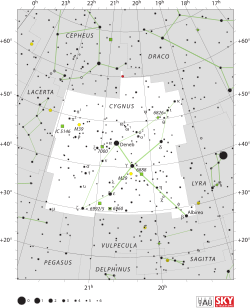Kepler-28
| Kepler-28 | |
 | |
| Observationsdata Epok: J2000.0 | |
|---|---|
| Stjärnbild | Svanen[1] |
| Rektascension | 19t 28m 32,8905s[2] |
| Deklination | +42° 25′ 45,959″[2] |
| Skenbar magnitud () | +15,036[3] |
| Stjärntyp | |
| Spektraltyp | M0 V[4] |
| Variabeltyp | Planetpassage-variabel |
| Astrometri | |
| Radialhastighet () | -26,99 ± 6,00[2] km/s |
| Egenrörelse (µ) | RA: -0,463[2] mas/år Dek.: +11,691[2] mas/år |
| Parallax () | 2,2537 ± 0,0185[2] |
| Avstånd | 1 450 ± 10 lå (444 ± 4 pc) |
| Detaljer | |
| Massa | 0,684 ± 0,026[5] M☉ |
| Radie | 0,664 ± 0,013[5] R☉ |
| Temperatur | 4 499 ± 75[5] K |
| Metallicitet | -0,17 ± 0,11[4] |
| Vinkelhastighet | 0,6[3] km/s |
| Ålder | 2,2[6] miljarder år |
| Andra beteckningar | |
| Kepler-28, KOI-870, UCAC4 663-076514, AP J19283288+4225459, KIC 6949607, 2MASS J19283288+4225459, Gaia DR3 2125731464014361088, Gaia DR2 2125731464014361088[7][8] | |
Kepler-28, även känd som KOI-870, är en ensam stjärna i mellersta delen av stjärnbilden Svanen, inom synfältet för Keplerteleskopet. Den har en skenbar magnitud av ca 15,036[3] och kräver ett kraftfullt teleskop för att kunna observeras. Baserat på parallax enligt Gaia Data Release 3 på ca 2,25 mas[2] beräknas den befinna sig på ett avstånd av ca 1 450 ljusår (ca 444 parsec) från solen. Den rör sig närmare solen med en heliocentrisk radialhastighet av ca -27 km/s.[2]
Egenskaper
[redigera | redigera wikitext]Kepler-28 är en orange till gul stjärna i huvudserien av spektralklass M0 V.[4] Den har en massa av ca 0,68[5] solmassa, en radie av ca 0,66[5] solradier och har en effektiv temperatur av ca 4 500 K.[5]

Planetsystem
[redigera | redigera wikitext]De två transitplaneterna hos Kepler-28 upptäcktes 2011 med Keplerteleskopet och bekräftades i början av 2012.[9] De är båda varma sub-Neptunus gasplaneter.[6] De planetära parametrarna uppdaterades 2023, med lägre värden för hela massan, radien och densiteten jämfört med tidigare uppskattningar.[5]
(AE) |
(d) |
|||||
|---|---|---|---|---|---|---|
Se även
[redigera | redigera wikitext]Referenser
[redigera | redigera wikitext]- Den här artikeln är helt eller delvis baserad på material från engelskspråkiga Wikipedia, Kepler-28, 26 augusti 2024.
Noter
[redigera | redigera wikitext]- ^ "Cygnus – constellation boundary", The Constellations, International Astronomical Union, hämtad 2011-12-15
- ^ [a b c d e f g h] Vallenari, A.; et al. (Gaia collaboration) (2023). "Gaia Data Release 3. Summary of the content and survey properties". Astronomy and Astrophysics. 674: A1. arXiv:2208.00211. Bibcode:2023A&A...674A...1G. doi:10.1051/0004-6361/202243940. S2CID 244398875. Gaia DR3 record for this source at VizieR.
- ^ [a b c] Kepler-28b, NASA Ames Research Center, archived from the original on 2012-05-03, hämtad 2011-12-06
- ^ [a b c d] Muirhead, Philip S.; Hamren, Katherine; et al. (May 2012). "Characterizing the Cool Kepler Objects of Interests. New Effective Temperatures, Metallicities, Masses, and Radii of Low-mass Kepler Planet-candidate Host Stars". The Astrophysical Journal Letters. 750 (2): L37. arXiv:1109.1819. Bibcode:2012ApJ...750L..37M. doi:10.1088/2041-8205/750/2/L37.
- ^ [a b c d e f g h] Leleu, A.; Delisle, J.-B.; et al. (January 2023). "Removing biases on the density of sub-Neptunes characterised via transit timing variations. Update on the mass-radius relationship of 34 Kepler planets". Astronomy & Astrophysics. 669: A117. arXiv:2207.07456. Bibcode:2023A&A...669A.117L. doi:10.1051/0004-6361/202244132.
- ^ [a b] Cubillos, Patricio; Erkaev, Nikolai V.; Juvan, Ines; Fossati, Luca; Johnstone, Colin P.; Lammer, Helmut; Lendl, Monika; Odert, Petra; Kislyakova, Kristina G. (2016), "An overabundance of low-density Neptune-like planets", Monthly Notices of the Royal Astronomical Society, 466 (2): 1868–1879, arXiv:1611.09236, Bibcode:2017MNRAS.466.1868C, doi:10.1093/mnras/stw3103, S2CID 119408956
- ^ https://simbad.cds.unistra.fr/simbad/sim-id?Ident=Kepler-28. Hämtad 2024-08-26.
- ^ "Kepler-28". SIMBAD. Centre de données astronomiques de Strasbourg. Hämtad 10 januari 2017.
- ^ Steffen, Jason H.; Fabrycky, Daniel C.; Ford, Eric B.; Carter, Joshua A.; Desert, Jean-Michel; Fressin, Francois; Holman, Matthew J.; Lissauer, Jack J.; Moorhead, Althea V.; Rowe, Jason F.; Ragozzine, Darin; Welsh, William F.; Batalha, Natalie M.; Borucki, William J.; Buchhave, Lars A.; Bryson, Steve; Caldwell, Douglas A.; Charbonneau, David; Ciardi, David R.; Cochran, William D.; Endl, Michael; Everett, Mark E.; Gautier III, Thomas N.; Gilliland, Ron L.; Girouard, Forrest R.; Jenkins, Jon M.; Horch, Elliott; Howell, Steve B.; Isaacson, Howard; et al. (2012), Transit Timing Observations from Kepler: III. Confirmation of 4 Multiple Planet Systems by a Fourier-Domain Study of Anti-correlated Transit Timing Variations, arXiv:1201.5412, Bibcode:2012MNRAS.421.2342S, doi:10.1111/j.1365-2966.2012.20467.x, S2CID 11898578




